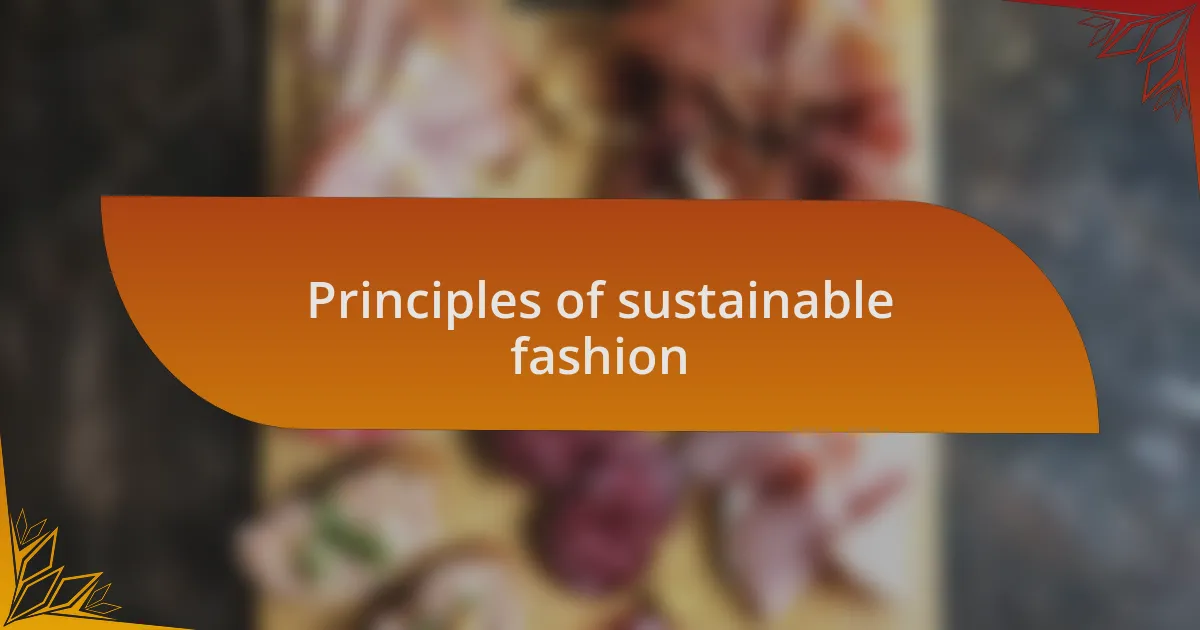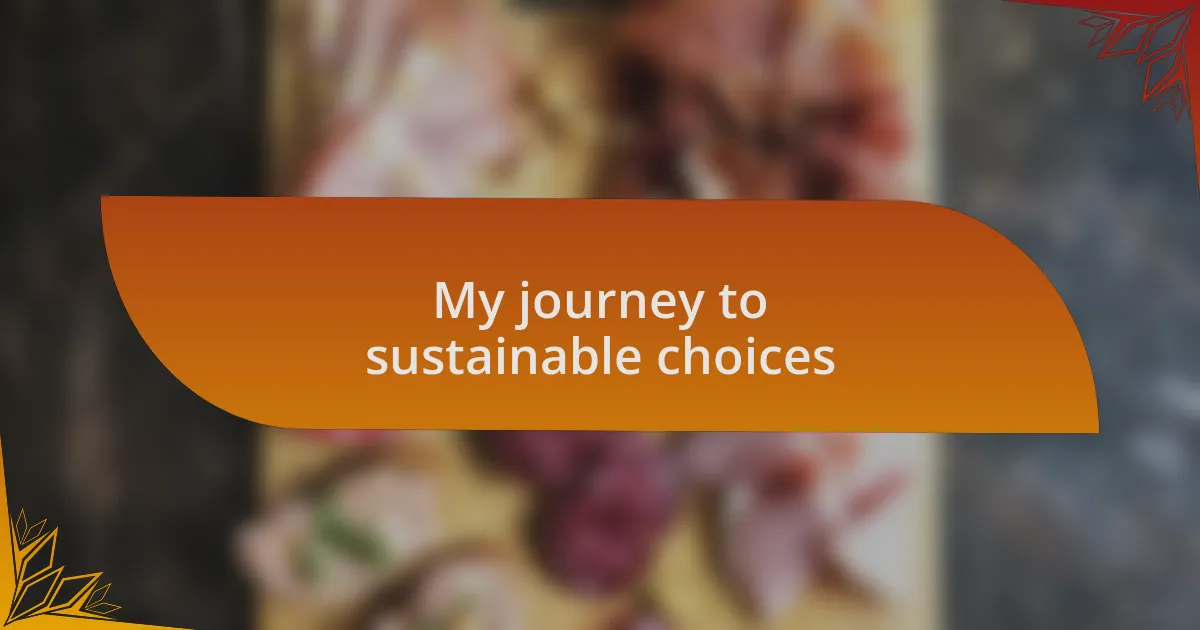Key takeaways:
- Fast fashion contributes to approximately 92 million tons of clothing waste annually and is responsible for about 10% of global carbon emissions.
- Sustainable fashion emphasizes eco-friendly materials, fair labor practices, and timeless designs to reduce environmental impact and promote ethical consumption.
- Implementing strategies like capsule wardrobes, clothing swaps, and upcycling can significantly reduce clothing waste and foster a deeper connection to personal garments.
- Collaborating with eco-friendly brands encourages responsible practices and enhances community engagement in sustainable fashion initiatives.

Understanding fast fashion waste
Fast fashion waste is a pressing issue that often goes unnoticed. I remember the excitement I felt when I bought a trendy shirt for a bargain price, only to realize a few weeks later it had already fallen apart. It makes me wonder, how many times have we contributed to this cycle of over-consumption, thinking we’re saving money while harming our planet?
The sheer volume of clothing discarded each year is staggering—approximately 92 million tons, according to recent research. It’s disheartening to think about how many items I accumulated over the years, each purchase seeming harmless at the time. Reflecting on this, I can’t help but ask, what if we shifted our perspective and valued quality over quantity in our wardrobes?
Moreover, the environmental impact extends beyond just the clothes we throw away. The production processes of fast fashion contribute to pollution and resource depletion. It hit me hard when I learned that the water used to grow cotton for a single T-shirt could fill up a whole bathtub. This revelation made me reconsider not just my shopping habits, but the broader implications of my choices on the environment.

The impact of fast fashion
The impact of fast fashion reaches far beyond our wardrobes; it ripples through our environment in alarming ways. I once stumbled upon a documentary that highlighted how many workers in fast fashion factories toil in unsafe conditions, often for meager pay. It struck me then—every piece of clothing I once thoughtlessly purchased carried a story of exploitation and environmental damage.
Let’s talk about landfills. Every year, millions of tons of textile waste end up in these vast spaces, and it takes years for synthetic fibers to break down. I vividly recall cleaning out my closet and throwing away bags of clothes I no longer wore. It was a bittersweet moment, realizing that those once-loved items would contribute to an ever-growing problem. Isn’t it sobering to think that each cheap purchase can lead to such long-lasting consequences?
Moreover, fast fashion is a massive contributor to carbon emissions, with the industry accountable for about 10% of global emissions. I found it eye-opening when I learned that simply wearing a garment longer can significantly reduce its environmental impact. When I made a conscious choice to buy fewer, better-quality pieces, I realized I wasn’t just changing my closet; I was also taking a stand for a healthier planet. What if we all embraced that change?

Principles of sustainable fashion
Sustainable fashion is grounded in principles that prioritize eco-friendliness and ethical production. One key aspect is the use of organic and recycled materials, which I’ve found can significantly reduce waste. When I decided to make the switch to brands that prioritize sustainable fabrics, I felt a deep sense of responsibility every time I wore them, knowing I was supporting a healthier planet.
Another important principle is fair labor practices. Recently, I visited a local boutique that sources its clothing from fair-trade artisans. Hearing the stories of these creators changed my perspective entirely. It struck me how their dedication to craftsmanship and ethics enhanced the value of the clothing I was considering. I asked myself: how much more meaningful is a garment when I know it embodies respect and fairness?
Lastly, the idea of timeless designs plays a crucial role in sustainable fashion. I’ve noticed that investing in classic pieces means I make fewer purchases over time. When I chose a well-made coat that suited my style and lasted through seasons, I realized how rewarding it was to move away from fleeting trends. Isn’t it refreshing to think that by embracing longevity in our wardrobes, we can pave the way for a more sustainable future?

The rise of green restaurants
The trend of green restaurants is blossoming as more consumers seek sustainable dining options. I remember my first visit to a farm-to-table restaurant; it felt different. The freshness of the ingredients and the commitment to local sourcing sparked an excitement in me. It was fascinating to realize that the meal I was enjoying was not just delicious, but also had a lower carbon footprint.
As I delved deeper into this eco-conscious dining scene, I noticed how green restaurants prioritize waste reduction. One establishment I frequent composts all its kitchen scraps and uses biodegradable takeout containers. It made me reflect on how these small choices can lead to significant environmental impact. Have you ever considered how much waste is generated from a single meal? It’s staggering, yet green restaurants tackle this challenge head-on.
Moreover, green restaurants often enhance the dining experience by connecting patrons to their food sources. I once attended a dinner where the chef shared stories about each ingredient, revealing its origin and the local farmers behind it. This personal touch created an emotional connection that transformed my meal into a memorable experience. Isn’t it remarkable how food can serve as a bridge—bringing us closer to the earth and to each other?

My journey to sustainable choices
As I started making sustainable choices in my life, I quickly realized that understanding the impact of my wardrobe was just as important as my food choices. I recall sorting through my closet and donating clothes I hadn’t worn in ages. That moment was eye-opening for me—it struck me how much waste we generate from fashion without even realizing it.
Then, I began to explore brands that prioritized ethical production and sustainable materials. There was a time I stumbled upon a small local boutique that exclusively sold second-hand clothing. Each item seemed to carry a story, and the thrill of finding a unique piece made me appreciate fashion in a whole new light. Have you ever felt that rush of excitement when you find something special that also feels right?
With each sustainable choice I made, I started feeling a sense of empowerment. It was as if I was taking control of my consumption habits while contributing to a larger movement. I think about how those small actions—the simple switch to buying vintage or supporting eco-friendly brands—are steps that propel us toward a more sustainable future. What are the choices you can make that resonate with your values?

Strategies to reduce clothing waste
One effective strategy I found was to embrace the concept of a capsule wardrobe. By carefully selecting versatile pieces that mix and match, I not only reduced my consumption but also made getting dressed a much simpler process. Have you ever noticed how a few well-chosen items can create countless outfits?
I also decided to host clothing swaps with friends. Not only did this allow us to refresh our wardrobes without spending a dime, but it also made for a fun and social experience. I remember the laughter, discussions about styles, and the thrill of rediscovering pieces that had been buried at the back of a closet. Each swap felt like a celebration of creativity and sustainability.
Every time I chose to repair or upcycle a damaged piece instead of tossing it, I experienced a sense of accomplishment. It reminded me that clothing isn’t just disposable; it can be cherished and transformed. By viewing my wardrobe as a collection of stories rather than mere items, I fostered a deeper connection to my clothes. What could you create if you looked at your clothing this way?

Collaborating with eco-friendly brands
Partnering with eco-friendly brands has been a game-changer for me in my journey to cut down on fast fashion waste. I vividly remember a collaboration with a local sustainable clothing line; each piece they created was crafted with care and purpose. It was refreshing to wear items that not only felt good but also aligned with my values. Have you ever felt that connection with a brand that truly resonates with your beliefs?
Working with ethical brands often opens up opportunities to learn more about responsible practices. During a recent event, I had the chance to speak with designers who prioritize organic materials and fair labor. Listening to their passion about creating clothes that don’t negatively impact the planet inspired me deeply. It made me wonder—how many people are unaware of the stories and hard work behind the garments they wear?
Engaging with eco-conscious brands has also led to unique and creative collaborations. I once organized a fashion pop-up with several like-minded companies, showcasing our sustainable efforts. The excitement was palpable as we exchanged ideas on marketing sustainable fashion while reducing waste. This experience taught me that by supporting each other, we can amplify our messages and inspire our communities to rethink their shopping habits. How can we collectively create a fashionable future without compromising the environment?